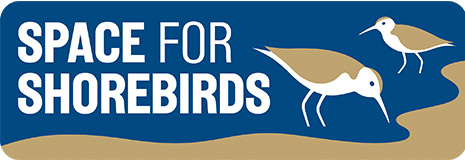Help Needed to Protect Nesting Ringed Plovers!
While it may sometimes feel like we are still in the depths of winter and that it will be a while before we think about shedding that extra layer (or five) when venturing outside, the days are definitely getting longer and that means that the wildlife on our doorsteps can sense that spring is just around the corner even if we can’t. Most of our small shorebird species will soon be heading off on migration to breed in the far North, with some even going as far as the Arctic circle. However, ringed plovers are one of the few that will stick around and raise their young on our coastlines. We are lucky that the Northumberland coast supports a substantial number of ringed plover pairs, and part of our work at Space for Shorebirds is to help give these tenacious little birds the best chance possible of successfully rearing their next generation.
These birds usually choose to nest right on our beaches, out in the open, on the stretch of shore between the high tide mark and the top of the beach. They need an area of sand, shingle, or small pebbles to make their nest, and will usually try to pick a spot away from any dense vegetation or other cover where it might be easier for predators to sneak up on them. When it comes to making their nest, they do little more than scrape a shallow bowl in the sand or shingle and lay their eggs directly on the ground. This may sound careless, but the markings on their eggs make them look almost indistinguishable from small pebbles, allowing them to go unnoticed by most. Usually, ringed plovers will choose to nest solitarily because they rely on their excellent camouflage to keep the nest site safe from predators, and one nest on its own is harder to spot than a group of nests together. They will make sure that they are the only pair using their patch of beach by claiming a breeding territory early in the year and chasing away any competitors that stray too close.
It can be quite difficult to spot a ringed plover territory, particularly when it is early in the season before they have laid their eggs and start defending the nest, but there are a few telltale signs to look out for. At this time of year if you see ringed plovers hanging around suitable breeding habitat, they could be checking it out as a potential territory (also known as “prospecting”). They might not seem to be doing much other than just hanging around, but this can be a good indicator that they might choose to nest there, particularly if they are doing this at low tide when they would usually be feeding further down the beach. You might also see them doing their courtship displays or conducting “butterfly flights”, where they fly round the edge of their territory with distinctive light movements (like a butterfly flapping its wings), or even see them mating. These are more concrete signs that they could be ready to lay their eggs any day.
 A ringed plover nest, or scrape, with a full clutch of 4 well camouflaged eggs
A ringed plover nest, or scrape, with a full clutch of 4 well camouflaged eggs
Often, one of the first ways that you notice there are ringed plovers around is when you hear them call. They have a distinctive alarm call that they use to signal to each other if they see a potential threat, and because they can be tricky to spot, you can often hear them before you see them. Alarm calling can be a great indicator that there is a ringed plover territory nearby, but it may also mean that the birds are feeling threatened by your presence. If you think that you can hear alarm calling and want to try and spot the birds, it’s best to move away and look back at where you heard the calls so that the birds will be more relaxed, and you will be more likely to see other exciting behaviours.
If faced with the imminent threat that a predator might find their nest or chicks, ringed plovers can also use an iconic distraction display, where the adults will feign an injury in the hope that the predator will follow them thinking they are about to get an easy meal. The parent bird will hold its wing out at an unnatural angle as if it is broken and flutter along on the ground in front of the predator while staying just out of reach until it has drawn the potential threat away from its young. If you ever see this behaviour, it is as good as you can get for a guarantee that there are chicks (or at least eggs) in the area, so be extra careful where you step and move away till the birds are calm.
 Kestrels are one of the main predators which will take ringed plover chicks
Kestrels are one of the main predators which will take ringed plover chicks
While there are some spots along our coast that ringed plovers return to year after year, many of the nests pop up wherever the habitat is looking best for that season. Therefore, finding these territories as early as possible is important so that we can put in place any nest protections needed. To do this we rely on our amazing team of Coast Care volunteers, who help us look out for signs of breeding activity all along the Northumberland coast through their ringed plover surveys. You can help too by letting us know if you see any of the behaviours mentioned above, if you do then send us a message on our social media letting us know what you saw, when, and where you saw it and we can use that information to help identify new breeding locations.


